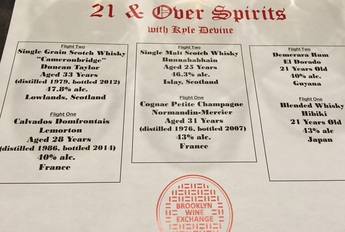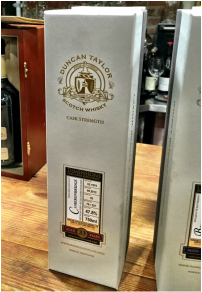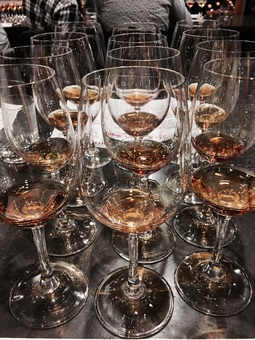 The best part of January is the whiskey potential it brings – another year of whiskies to try. And so it is that I am reviving my New Year’s resolution of trying 33 new whiskies in 30 days. I did not approach this challenge softly this year. I jumped right in with two well-aged Scotches and a Japanese whisky. They were part of a tasting for “spirits so old they can drink themselves,” since they are all over 21 years old. The tasting also featured a calvados, cognac, and rum. And brisket. Let me just say, it felt like the perfect meal – a bite of brisket, a sip of a 33-year-old Scotch, a bite of brisket, a taste of a 21-year-old Hibiki. If you want to feel truly fancy for an evening, that is how it’s done.  Our first whisky stop was Japan for the Hibiki 21-year. What we knew: It’s a blended whiskey, 86 proof What we discovered: The Scottish person at the table dismissed it as “blended whisky, cooking whisky.” While I do happen to cook with some pretty good whisky – I tend to use what I have and I don’t keep a lot of crappy whisky around – I would not relegate this to the cupboard next to my balsamic vinegar. It is a blended whisky, but I find Japanese whiskies to be kind and balanced. The more I drank, the more it took on a softness. Japanese use Mizunara (Japanese oak) barrels for their aging in addition to other more traditional barrels, like bourbon, and it gave this whisky nice sandalwood notes. It smelled higher proof than it was, so was a bit harsh on the nose, but was gentler on the palette. I would happily have a dram of this on most days. And I wouldn’t mind if a lot of my food tasted like it also.  Next up was a 33-year-old Scotch, Cameronbridge from Duncan Taylor. What we knew: A single grain whiskey, 90% wheat and 10% malted barley, from the Lowlands, 95.6 proof What we discovered: It’s pretty rare to come across a single grain Scotch. Normally single grain Scotches are made to be mixed with other Scotches and put in a blend, but I am so glad this one was given its own bottle. It tasted like a vanilla milkshake to me in all the best ways possible. My other reference for a wheated whiskey is American – Bernheim and Parker’s. And I like those, but this was something entirely different. This was creamy. I could eat it with a spoon. Or, like, an extremely large ladle. I would definitely trade in my single malt for a single grain that tastes like this.  Our other Scotch of the evening was the Bunnahabhain. First off, I think this gets cutest name from Scotland. I don’t know how you actually say it, but it’s adorable with all those b’s. If there is a whisky gnome, it should definitely be named Little Bunnahabhain. What we knew: 25 years old, 92.6 proof, single malt from Islay What we discovered: So when someone says Islay, my mind screams “peat!” And my mouth gets ready to take in some smoke. But not this guy. It was mild on the peat and instead had seaside briny flavors, like smelling a tide pool. I enjoy tide pools, so that’s a compliment. This with some oysters at a little pub on a stormy Scottish beach. Take me there - now. It was also buttery with hints of almond. I know a slightly smoky, briny almond doesn’t necessarily sound like it works, but it worked for this bottle. And there we are. I feel like I am off to a new adventure for the next month. Just when I think I can’t find any new way to describe whisky, that there can’t possibly be more flavors for the same basic ingredients, I run into a vanilla milkshake and a tide pool, and I am reminded how unique each whisky is.
0 Comments
Your comment will be posted after it is approved.
Leave a Reply. |
Archives
November 2017
|

 RSS Feed
RSS Feed
